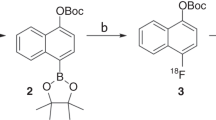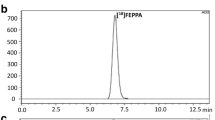Abstract
Purpose
Innate immune activation plays a critical role in the onset and progression of many diseases. While positron emission tomography (PET) imaging provides a non-invasive means to visualize and quantify such immune responses, most available tracers are not specific for innate immune cells. To address this need, we developed [18F]OP-801 by radiolabeling a novel hydroxyl dendrimer that is selectively taken up by reactive macrophages/microglia and evaluated its ability to detect innate immune activation in mice following lipopolysaccharide (LPS) challenge.
Procedures
OP-801 was radiolabeled in two steps: [18F]fluorination of a tosyl precursor to yield [18F]3-fluoropropylazide, followed by a copper-catalyzed click reaction. After purification and stability testing, [18F]OP-801 (150-250 μCi) was intravenously injected into female C57BL/6 mice 24 h after intraperitoneal administration of LPS (10 mg/kg, n=14) or saline (n=6). Upon completing dynamic PET/CT imaging, mice were perfused, and radioactivity was measured in tissues of interest via gamma counting or autoradiography.
Results
[18F]OP-801 was produced with >95% radiochemical purity, 12–52 μCi/μg specific activity, and 4.3±1.5% decay-corrected yield. Ex vivo metabolite analysis of plasma samples (n=4) demonstrated high stability in mice (97±3% intact tracer >120 min post-injection). PET/CT images of mice following LPS challenge revealed higher signal in organs known to be inflamed in this context, including the liver, lung, and spleen. Gamma counting confirmed PET findings, showing significantly elevated signal in the same tissues compared to saline-injected mice: the liver (p=0.009), lung (p=0.030), and spleen (p=0.004). Brain PET/CT images (summed 50–60 min) revealed linearly increasing [18F]OP-801 uptake in the whole brain that significantly correlated with murine sepsis score (r=0.85, p<0.0001). Specifically, tracer uptake was significantly higher in the brain stem, cortex, olfactory bulb, white matter, and ventricles of LPS-treated mice compared to saline-treated mice (p<0.05).
Conclusion
[18F]OP-801 is a promising new PET tracer for sensitive and specific detection of activated macrophages and microglia that warrants further investigation.






Similar content being viewed by others
References
Werry EL, Bright FM, Piguet O, Ittner LM, Halliday GM, Hodges JR, Kiernan MC, Loy CT, Kril JJ, Kassiou M (2019) Recent developments in TSPO PET imaging as a biomarker of neuroinflammation in neurodegenerative disorders. Int J Mol Sci 20(13):3161
Krause DL, Müller N (2010) Neuroinflammation, microglia and implications for anti-inflammatory treatment in Alzheimer’s disease. Int J Alzheimers Dis 2010:1–9
Lambert J-C, Heath S, Even G, Campion D, Sleegers K, Hiltunen M, Combarros O, Zelenika D, Bullido MJ, Tavernier B (2009) Genome-wide association study identifies variants at CLU and CR1 associated with Alzheimer’s disease. Nat Genet 41(10):1094–1099
Alam MM, Lee J, Lee SY (2017) Recent progress in the development of TSPO PET ligands for neuroinflammation imaging in neurological diseases. Nucl Med Mol Imaging 51(4):283–296. https://doi.org/10.1007/s13139-017-0475-8
Chaney A, Deal EM, Jackson IM, James ML (2021) PET Imaging of Neuroinflammation. In: Ross, Gambhir (eds) Molecular Imaging: Principles and Practice, chap 68. Elsevier Inc., pp 1337–1373
Henningfield CM, Cleland JL, Sharma R, Green KN (2020) Selective targeting of plaque-associated microglia through systemic dendrimer administration in an Alzheimer’s disease model. Alzheimers Dement 16(S2):e040661. https://doi.org/10.1002/alz.040661
Jain P, Chaney AM, Carlson ML, Jackson IM, Rao A, James ML (2020) Neuroinflammation PET imaging: current opinion and future directions. J Nucl Med 61(8):1107–1112
Gui Y, Marks JD, Das S, Hyman BT, Serrano-Pozo A (2020) Characterization of the 18 kDa translocator protein (TSPO) expression in post-mortem normal and Alzheimer’s disease brains. Brain Pathol 30(1):151–164
Owen DR, Yeo AJ, Gunn RN, Song K, Wadsworth G, Lewis A, Rhodes C, Pulford DJ, Bennacef I, Parker CA et al (2012) An 18-kDa translocator protein (TSPO) polymorphism explains differences in binding affinity of the PET radioligand PBR28. J Cereb Blood Flow Metab 32(1):1–5. https://pubmed.ncbi.nlm.nih.gov/22008728. https://doi.org/10.1038/jcbfm.2011.147
Stanley ER, Chitu V (2014) CSF-1 receptor signaling in myeloid cells. Cold Spring Harb Perspect Biol 6(6):a021857. https://pubmed.ncbi.nlm.nih.gov/24890514. https://doi.org/10.1101/cshperspect.a021857
Spinelli F, Mu L, Ametamey SM (2018) Radioligands for positron emission tomography imaging of cannabinoid type 2 receptor. J Label Compd Radiopharm 61(3):299–308
Kannan S, Dai H, Navath RS, Balakrishnan B, Jyoti A, Janisse J, Romero R, Kannan RM (2012) Dendrimer-based postnatal therapy for neuroinflammation and cerebral palsy in a rabbit model. Sci Transl Med 4(130):130ra46
Mishra MK, Beaty CA, Lesniak WG, Kambhampati SP, Zhang F, Wilson MA, Blue ME, Troncoso JC, Kannan S, Johnston MV et al (2014) Dendrimer brain uptake and targeted therapy for brain injury in a large animal model of hypothermic circulatory arrest. ACS Nano 8(3):2134–2147. https://pubmed.ncbi.nlm.nih.gov/24499315. https://doi.org/10.1021/nn404872e
Perumal OP, Inapagolla R, Kannan S, Kannan RM (2008) The effect of surface functionality on cellular trafficking of dendrimers. Biomaterials 29(24–25):3469–3476
Zhang F, Nance E, Alnasser Y, Kannan R, Kannan S (2016) Microglial migration and interactions with dendrimer nanoparticles are altered in the presence of neuroinflammation. J Neuroinflammation 13(1):1–11
Nance E, Zhang F, Mishra MK, Zhang Z, Kambhampati SP, Kannan RM, Kannan S (2016) Nanoscale effects in dendrimer-mediated targeting of neuroinflammation. Biomaterials 101:96–107
Turk BR, Nemeth CL, Marx JS, Tiffany C, Jones R, Theisen B, Kambhampati S, Ramireddy R, Singh S, Rosen M (2018) Dendrimer–N-acetyl-L-cysteine modulates monophagocytic response in adrenoleukodystrophy. Ann Neurol 84(3):452–462
Niño DF, Zhou Q, Yamaguchi Y, Martin LY, Wang S, Fulton WB, Jia H, Lu P, Prindle T Jr, Zhang F (2018) Cognitive impairments induced by necrotizing enterocolitis can be prevented by inhibiting microglial activation in mouse brain. Sci Transl Med 10(471):eaan0237
Alnasser Y, Kambhampati SP, Nance E, Rajbhandari L, Shrestha S, Venkatesan A, Kannan RM, Kannan S (2018) Preferential and increased uptake of hydroxyl-terminated PAMAM dendrimers by activated microglia in rabbit brain mixed glial culture. Molecules 23(5):1025
Cai KC, van Mil S, Murray E, Mallet J-F, Matar C, Ismail N (2016) Age and sex differences in immune response following LPS treatment in mice. Brain Behav Immun 58:327–337. https://doi.org/10.1016/j.bbi.2016.08.002https://www.sciencedirect.com/science/article/pii/S0889159116303592
Klein SL, Flanagan KL (2016) Sex differences in immune responses. Nat Rev Immunol 16(10):626–638. https://doi.org/10.1038/nri.2016.90
James ML, Shen B, Zavaleta CL, Nielsen CH, Mesangeau C, Vuppala PK, Chan C, Avery BA, Fishback JA, Matsumoto RR et al (2012) New positron emission tomography (PET) radioligand for imaging σ-1 receptors in living subjects. J Med Chem 55(19):8272–8282. https://doi.org/10.1021/jm300371c
Chaney AM, Johnson EM, Cropper HC, James ML (2018) PET imaging of neuroinflammation using [11C]DPA-713 in a mouse model of ischemic stroke. J Vis Exp (136):e57243. https://www.jove.com/t/57243. https://doi.org/10.3791/57243
Shrum B, Anantha RV, Xu SX, Donnelly M, Haeryfar SMM, McCormick JK, Mele T (2014) A robust scoring system to evaluate sepsis severity in an animal model. BMC Res Notes 7(1):233. https://doi.org/10.1186/1756-0500-7-233
Tunki L, Kulhari H, Bhargava SK, Pooja D (2020) 4 - Pharmacokinetic considerations in design of dendrimer-based nanomedicines. In: Chauhan A, Kulhari HBT-PA of D (eds) Micro and Nano Technologies. Elsevier, pp 93–106. https://www.sciencedirect.com/science/article/pii/B9780128145272000044. https://doi.org/10.1016/B978-0-12-814527-2.00004-4
Catorce MN, Gevorkian G (2016) LPS-induced murine neuroinflammation model: main features and suitability for pre-clinical assessment of nutraceuticals. Curr Neuropharmacol 14(2):155–164. https://pubmed.ncbi.nlm.nih.gov/26639457. https://doi.org/10.2174/1570159x14666151204122017
Zhao J, Bi W, Xiao S, Lan X, Cheng X, Zhang J, Lu D, Wei W, Wang Y, Li H et al (2019) Neuroinflammation induced by lipopolysaccharide causes cognitive impairment in mice. Sci Rep 9(1):5790. https://doi.org/10.1038/s41598-019-42286-8
Furube E, Kawai S, Inagaki H, Takagi S, Miyata S (2018) Brain region-dependent heterogeneity and dose-dependent difference in transient microglia population increase during lipopolysaccharide-induced inflammation. Sci Rep 8(1):2203. https://doi.org/10.1038/s41598-018-20643-3
Hart AD, Wyttenbach A, Perry VH, Teeling JL (2012) Age related changes in microglial phenotype vary between CNS regions: grey versus white matter differences. Brain Behav Immun 26(5):754–765. https://pubmed.ncbi.nlm.nih.gov/22155499. https://doi.org/10.1016/j.bbi.2011.11.006
Silverman HA, Dancho M, Regnier-Golanov A, Nasim M, Ochani M, Olofsson PS, Ahmed M, Miller EJ, Chavan SS, Golanov E et al (2015) Brain region-specific alterations in the gene expression of cytokines, immune cell markers and cholinergic system components during peripheral endotoxin-induced inflammation. Mol Med 20(1):601–611. https://pubmed.ncbi.nlm.nih.gov/25299421. https://doi.org/10.2119/molmed.2014.00147
Zhang F, Trent Magruder J, Lin Y-A, Crawford TC, Grimm JC, Sciortino CM, Wilson MA, Blue ME, Kannan S, Johnston MV et al (2017) Generation-6 hydroxyl PAMAM dendrimers improve CNS penetration from intravenous administration in a large animal brain injury model. J Control Release 249:173–182. https://pubmed.ncbi.nlm.nih.gov/28137632. https://doi.org/10.1016/j.jconrel.2017.01.032
Funding
The authors would like to acknowledge Ashvattha Therapeutics, NSF GRFP Grant Number: DGE – 1656518 for funding.
Author information
Authors and Affiliations
Contributions
M.L.C. conceptualization, methodology, formal analysis, investigation, radiochemistry methodology and investigation, writing original draft, and creating figures. E.C.A., S.R., I.A., and S.N. investigation and manuscript review and editing. I.M.J. radiochemistry conceptualization, methodology, and investigation and manuscript writing and editing. R.K. radiochemistry methodology and investigation and manuscript review and editing. J.B.C. and R.S. radiochemistry conceptualization and methodology and manuscript review and editing. M.B. and J.C. supervision, funding acquisition, and manuscript review and editing. B.S. radiochemistry conceptualization, methodology, and investigation, supervision, and manuscript writing and editing. M.L.J. conceptualization, study design, data interpretation, manuscript writing and editing, supervision, and funding acquisition.
Corresponding author
Ethics declarations
Conflict of Interest
M.L.C., I.M.J., C.A., B.S., and M.L.J receive research funding and materials from Ashvattha Therapeutics. M.B., R.S., and J.C. are employees of Ashvattha Therapeutics.
Additional information
Publisher’s Note
Springer Nature remains neutral with regard to jurisdictional claims in published maps and institutional affiliations.
Supplementary Information
ESM 1
(DOCX 595 kb)
(MP4 212 KB)
Rights and permissions
Springer Nature or its licensor (e.g. a society or other partner) holds exclusive rights to this article under a publishing agreement with the author(s) or other rightsholder(s); author self-archiving of the accepted manuscript version of this article is solely governed by the terms of such publishing agreement and applicable law.
About this article
Cite this article
Carlson, M.L., Jackson, I.M., Azevedo, E.C. et al. Development and Initial Assessment of [18F]OP-801: a Novel Hydroxyl Dendrimer PET Tracer for Preclinical Imaging of Innate Immune Activation in the Whole Body and Brain. Mol Imaging Biol 25, 1063–1072 (2023). https://doi.org/10.1007/s11307-023-01850-5
Received:
Revised:
Accepted:
Published:
Issue Date:
DOI: https://doi.org/10.1007/s11307-023-01850-5




